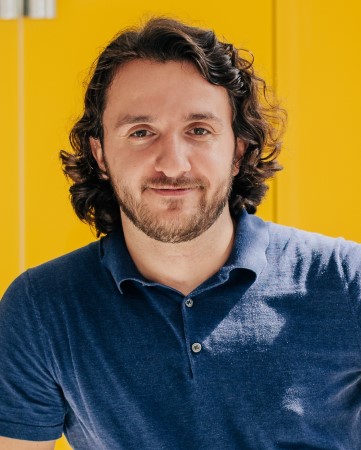BBDC Member Profile
Eno Hysi, PhD
September 2023
By Krista Lamb
 When it comes to diabetes research, people are far more likely to think physiology before physics, but Dr. Eno Hysi is turning that assumption on its head. Dr. Hysi, a Staff Scientist at the Keenan Research Centre for Biomedical Science at St. Michael’s Hospital and an Assistant Professor in the Department of Medical Biophysics at the University of Toronto, is using his background in physics to better visualize our understanding of diabetic kidney disease.
When it comes to diabetes research, people are far more likely to think physiology before physics, but Dr. Eno Hysi is turning that assumption on its head. Dr. Hysi, a Staff Scientist at the Keenan Research Centre for Biomedical Science at St. Michael’s Hospital and an Assistant Professor in the Department of Medical Biophysics at the University of Toronto, is using his background in physics to better visualize our understanding of diabetic kidney disease.
Graduating with a PhD in physics from Toronto Metropolitan University (TMU), Hysi looked for ways to combine his love for physics with his interest in biology. “I was drawn to physics through a passion for trying to understand the natural world,” he says. “And I discovered that there’s so much physics in medicine and biology. I was fortunate that at the time I decided to enter TMU, they had a program called Medical Physics, which is the study of physics and its applications in medicine. I realized that there’s so much physics in virtually every branch of medicine.”
Hysi did his postdoctoral studies in the lab of BBDC member, Dr. Darren Yuen, at the University of Toronto. There, he was able to learn more about both kidney transplant and fibrosis and discover ways in which he could potentially contribute to research in those areas.
In starting his own research program, the Translational Ultrasound and Photoacoustic Imaging Laboratory (TUPIL), Hysi hoped to find ways to use his unique skill set to help patients. In his role at St. Michael’s Hospital, home to one of the largest kidney transplant programs in Canada, he has found new and innovative ways to use physics in the study of diabetic kidney disease. “I’m interested in trying to find a way to help clinicians better visualize diabetic kidney injury,” he says. “Just because you have that diagnosis, exactly how much damage the kidney has sustained is not always immediately clear. Using my physics training, I developed medical imaging techniques, in particular, something called photoacoustic imaging, which combines laser and ultrasound together. I’m interested in studying various structural and functional aspects of diabetic kidney injury.”
Being able to fully visualize what is happening to the blood vessels inside the kidney as they develop disease, or to see how much scarring has formed in the organ, could help clinicians make more informed decisions about transplants, as well as to develop better drugs and interventions for the various stages of diabetic kidney disease.
Hysi’s team, in collaboration with nephrologists and urologists, is currently running a clinical trial of 70 patients, many of whom have had diabetic kidney disease, to measure the quality of transplanted kidneys as they go into the recipient. They want to assess the injuries that are present before transplant to see if there are ways to predict future kidney function. This process, if successful, could one day remove the need for kidney biopsies, which are much more invasive and difficult for the patient, or help transplant surgeons gauge the long-term viability of a donor kidney.
While still in the very early days, the research is intriguing. Hysi’s team wants to understand what a given amount of, for example, fibrosis and vascular damage in the graft at the time of transplant will mean for that kidney in the future. The team just had 34 patients pass the one-year mark post-transplant, providing new and interesting data points. In the future, they hope to collect enough data based on their kidney imaging to help clinicians determine personalized care pathways for patients. While it’s still a long way off, the goal of finding more effective and less invasive ways to improve transplant outcomes for people with diabetic kidney disease is at the forefront of all research, and clinical trials currently being led by the Hysi lab.
The BBDC is helping support that goal. Hysi spoke at the Centre’s 2023 Scientific Day and has been able to tap into mentorship and collaboration with experts in diabetes from across the spectrum through his membership. “I really consider being part of the BBDC a learning opportunity for me, especially coming from outside the domain of diabetes. Hopefully I can provide the spectacular fundamental and translational researchers that the BBDC houses with a new tool, right in their arsenal, for taking care of diabetes,” he says. “My goal is to work with the BBDC members to learn what is important to them, what questions remain unanswered in their research programs and to try and give them a hand in answering them using imaging.”
